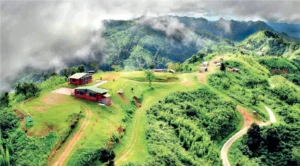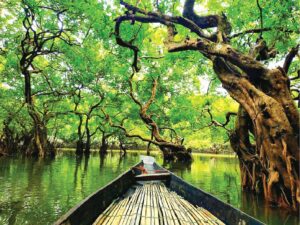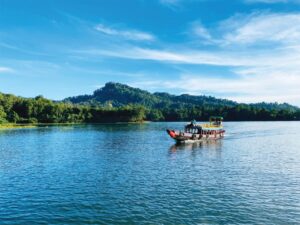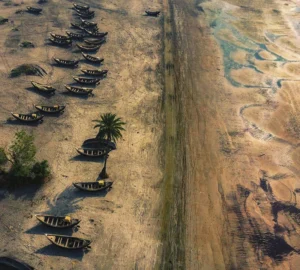Scenic Sights

FROM UP ON MAJESTIC HILLS FROM UP ON MAJESTIC HILLS THE PICTURESQUE BEAUTY OF RESORTS
Discovering A Gem Like Sairu, Amidst The Serena Hills Of Bandarban, Will Feel Like Uncovering A Hidden Treasure. The Experience Will Be Nothing Short Of Magical, Blending Natural Beauty With A Sense Of Tranquility That Only The Mountains Can Provide. Sairu is a contemporary eco-resort that blends modern luxury with natural harmony. Designed with sustainability in mind, it incorporates local materials like stone and bamboo to create a rustic yet refined aesthetic that seamlessly integrates with the surrounding environment. If given a choice between the beach and the mountains, I wouldn’t hesitate to pick the mountains. Exploring mountainous terrain has always been a source of joy for me, and discovering a gem like Sairu, amidst the serene hills of Bandarban, felt like uncovering a hidden treasure. The experience was nothing short of magical, blending natural beauty with a sense of tranquillity that only the mountains can provide. The resort is around a 40-minute drive from Bandarban town. Upon entering the compound of Sairu, the f irst thing that will grab your attention is how everything looks in place and blends effortlessly with the surrounding topography. There is not a single element or structure you will find there that is off-putting. To the entrance left of lies the the reception and dining area, nestled beside a tranquil water body. From the hanging balcony of the eating zone, the panoramic view of the towering hills and the Shanghu River is breathtaking, offering a visual feast that captures the essence of Bandarban’s serene charm. To the right of the entrance, cottages are arranged in terraced layers along the hillside, accessible only via steps. For those less accustomed to physical activity, the steep climb might feel challenging, especially with frequent trips. However, the effort is well rewarded with changing, picturesque views at every turn. Mini golf carts are available for transporting luggage and assisting individuals with disabilities. At the hill’s summit lies the infinity pool and jacuzzi, offering unparalleled vistas. Rest stops throughout the resort invite you to pause and enjoy the stunning beauty of Bandarban. Long ago in Bandarban, a Mro princess named Sairu fell in love with a prince from a rival hill tribe, defying tribal rules. Their secret meetings ended tragically when the prince was forced into an arranged marriage. Heartbroken, Sairu disappeared into the hills. The resort is named after this story, with “Sairu Point” marked by entwined trees on a hill, symbolizing their love. The Sairu Hill Resort draws its name and logo from this legend, preserving its memory for visitors to honor. Sairu is a contemporary eco-resort that blends modern luxury with natural harmony. Designed with sustainability in mind, it incorporates local materials like stone and bamboo to create a rustic yet refined aesthetic that seam lessly integrates with the surrounding environment. The cottages at Sairu are thoughtfully priced, offering options tailored to your preferred view. Each cottage features a private balcony and a spacious washroom with a unique, nature-facing concrete bathtub—a rare luxury in the country. The rooms are generously sized and adorned with colorful jute rugs, bamboo curtains, and furniture crafted from tree logs. A standout piece is the giant coffee table, made from a single slice of a tree trunk. Modern amenities such as toiletries, skincare essentials, laundry services, and safes ensure a comfortable stay. The culinary excellence of the resort is also a notable mention if you are into local cuisine. Their downhill restaurant provides all kinds of meals and offers both à la carte menus with diverse cuisines and buffet options. Open to all visitors, not just guests, it welcoming provides space a for anyone looking to enjoy a meal amid the serene surroundings. There is also a badminton court in another part of the downhill. The resort’s design and execution were spearheaded by DOMUS, a renowned architectural consultancy in Bangladesh, with Principal Architect Mustafa Ameen envisioning a “less is more” approach. The master plan was crafted to respect the natural terrain, with structures elevated on steel stilts to preserve the contours and existing trees left untouched. Additional greenery enhanced the landscape, ensuring harmony with the surroundings. Maximizing panoramic views, the design integrates modern luxury with environmental sensitivity, with the only major alteration being the driveway carved into the hill. Water was sourced from a spring 1,200 feet below, showcasing remarkable ingenuity. The mornings at Sairu are invigorating, with a gentle breeze whispering through the trees, while nighttime transforms into a magical spectacle, as the starlit sky casts an enchanting spell, leaving visitors in awe. Once you are inside Sairu, you will not feel the need to go elsewhere, as the tasteful setup with modern amenities will you amazed. But, yet, if you have plans to keep explore the surroundings, Sairu will arrange that for you. You can rent a jeep or CNG from them and explore the nearby tourist attractions like Nilgiri Mountain. Written By Kaniz Supriya
Read More
Caressing The Clouds From 3,235 Feet Above in Bandarban
Bandarban is more like a complete, separate entity and a world of its own, lying gracefully and peacefully on the south-eastern part of Bangladesh. When the lethargy hits you amid the daily blues, this place can work as a whimsical healer and boost our weary souls.
Read More
RATARGUL Gowain’s Serene
Only a decade back, when considering a trip to Sylhet, most would think about visiting the lush green heavens of tea tree leaves at the wavy hills of century-old tea estates and the waterfalls. However, over the years, a freshwater swamp forest that flows through the arteries of Gowainghat, has cemented its place in the hearts of thousands of tourists who flocks there every season. It is the only swamp forest of sweet water in Bangladesh. The mighty Meghalaya pours into the Gowain, and a stream flows through the Chengi canal, flooding the entire region under 20-30 feet of water where serenely rests Ratargul with mysticism. Ratargul has an addictive aura. It is one of those spaces where one has to be physically present and let themselves be entirely engulfed by its charm to feel its truest essence. And Ratargul in monsoon, is impossible to encapsulate with words. Water lilies, both white and pink varieties, are a common sight, adding a soothing touch to the landscape. These floating plants not only enhance the beauty of the forest but also provide essential habitat and food for various aquatic creatures. One will also notice slender and tall cypress trees rise majestically from the water, creating a picturesque backdrop. There are numerous other kinds of tress, and once in a while you might be welcomed by monkeys hanging from them or birds singing back to the boatmen. These trees not only offer shelter to numerous bird species but also contribute to the overall biodiversity of the forest. Swamp Forest The moist and humid conditions of Ratargul support the growth of mosses and ferns too. They cover the rocks and tree trunks. Reaching Ratargul requires careful planning, as it is situated in a remote area. Here’s how to get there: By Air: The nearest major airport to Ratargul is Osmani International Airport in Sylhet. From the airport, you can hire a taxi or take a bus to reach Ratargul. By Road: You can reach Ratargul by road from Sylhet city. The journey takes 1.5-2 hours, and you can hire a taxi or use public transportation. Local Transport: Once you reach the nearest village, Gowainghat, you’ll need to hire a local guide or a boat to navigate through the water channels that lead to Ratargul. The boat ride is an integral part of the Ratargul experience, offering stunning views of the surrounding landscape. While Ratargul itself is typically a day-trip destination, you can find accommodation in nearby areas for a comfortable stay during your visit. The beautiful Sylhet city offers a wide range of accommodation options, including hotels, guesthouses, and resorts. It’s a convenient base for exploring other attractions in the region as well. Furthermore, the nearest town to Ratargul is Gowainghat, where you can find guesthouses and lodges. There are eco-resorts for a unique and eco-friendly experience, consider staying in one of the eco-resorts that have been established near Ratargul. These accommodations are often designed to blend seamlessly with the natural surroundings, providing a rustic yet comfortable experience. While planning your visit, remember to adhere to responsible tourism practices to protect this fragile ecosystem for future generations. A visit to Ratargul promises to be an unforgettable journey into the heart of nature’s wonders. Ratargul invites you to be its guest, offering a chance to escape the hustle and bustle of daily life and reconnect with the natural world. We must respect the regulations in place, support local communities, and engage with local guides who can deepen our understanding of this unique ecosystem. By doing so, we not only enhance our own experience but also contribute to conservation efforts that ensure Ratargul remains a pristine sanctuary for generations to come. It’s more than just a tourist destination – a testament to the exquisite beauty and resilience of the natural world. It is a place where you can find solace, inspiration, and a profound connection to the environment. Let’s also ensure that Ratargul’s magic endures for all to experience and cherish.
Read More
RANGAMATI After Gondwana Split
What oozes through your psyche when you hear the word “Rangamati”? For those who have never been there, it might be their half-blurry memories of their very first introduction to the space through their family albums holding photographs shot on a 35mm roll with a Yashica of their newly married parents standing atop a hill with the view of a boundless blue waterbody on the backdrop, or peculiar visuals and texts from their shoddily printed middle school textbooks, where they might have scribbled humorous drawings later on. Whilst for others, it might be freshly baked memories from their last winter trip with friends at the space. Memories of meeting mesmerizing fauna and flora while on a hike through the thrilling trails and their first ever kayaking experience full of excitement and sudden waves of mild fear of drowning from time to time, as they kept the crutch strap locks on check of the old orange life jacket embracing their torso. And for some, finally inhaling the clouds straight into their soul, something they have always envisioned when swimming inside deep daydreams while listening to their favorite romantic music in the background and seeping through the lines of their favorite book about life from a beloved author. But how many of us have actually ever intended to put an honest effort to understand, respect history and internalize the truest essence of a space like Rangamati instead of just always perceiving such spaces like the mindlessly romanticized gazes and activities of the typical tourists, especially in this era of travel package advertisements consisting of hideous drone footages floating around social media? Rangamati is Rangamati, well the entire Chittagong Hill Tracts are a lot more than just an alluring tourist attraction from our southeast and the tessellated spiels. Travellers should be mindful, hence, the least we can try is to educate ourselves and others regarding the complex historical and contemporary contexts of the space from veracious sources, acknowledge the authenticity and try to be on the right side of history. Rangamati is indeed a living embodiment of the meaning of its name, ‘colorful soil’. Millions of years ago Gondwana decided to split, forcing the Indian plate to drift northward and collide with the Eurasian plate resulting in the creation of the Tibetan Plateau which breathes the mighty Himalayas. And due to these otherworldly collisions taking place, the low-lying world’s biggest delta which also later formed from the sediments of the same Himalayas, got its gift of high-altitude lands on the fringes of its body, notably in the southeast where Rangamati serenely rests tall. This geographical history also explains why the region has a complex topography, shaped by the erosion and weathering processes. The distinct features of the myriad of hills, valleys, and water bodies are the result of the geological activities going on for eons and in light of this geographical history and map of present-day Bangladesh, it won’t be an exaggeration to say that Rangamati rose before, watching over the rest. Just like its original inhabitants came before us Bengalis. The main attraction of Rangamati is the Kaptai Lake with its scenic splendor. Created in 1960, it is the largest artificial lake of the country having a surface area of 58,500 acres and water holding capacity of 525,000 m3. The lake, dotted with islands, captivates the tourists with its beauty and calmness. Dumlong, considered to be the third highest mountain peak in the country, belonging to the Rentlang Range is about 3,316 feet in height and located in the Bilaichhari Upazila of Rangamati. Roughly thirteen thousand five hundred acres, this fighting land of the ancient kings also boasts as the largest district in the country in terms of land area and also the only district to share international borders with two other neighboring countries, India and Myanmar. The aura of this place will forever be onerous to describe with words regardless of the copious sum of visual and textual information on the internet about the place, starting from must-visit areas to food to accommodation. It is one of those spaces where one has to be physically present and gradually attempt to internalize the rest in order to get the taste of its inexplicable flavor, to the least. The indigenous folks lurking through the veins of Shuvolong; the piercing reverberation of the not to be spoken tales buried beneath the bloody blues of Kaptai; getting lost in a hiraeth of a never confessed love while inhaling the waves of floating white cotton candies straight into the deepest labyrinth of the soul; the shimmery kisses of the full moon dancing like a mystic ballerina all over Karnaphuli’s body as the million years old wind from the unfamiliar mountains caress your hair and softly shuts your eyelids making your mind trek through the fresh memories of trekking and the smell of limestone from the dimly lit rooms inside the heart of Alutila, or the star gazing nights spent on the adibashi village which shook you with the most chasmic lesson of anthropology; one can never get overdosed from the lures of Rangamati, they can either dissolve within its magic or leave parts of their soul and come back from time to time in quests to search for it. Even deliberately letting it go every time they meet their soul, only to use it as an excuse to return the space in the albino fogs of winter, in the magnanimous drizzles of monsoon over the acres of inclined jhum fields and to hold the dry leaves resting over cold palms like mannequins of butterflies waiting to take flight with the winds of the autumn. One of the most well-known tourist destinations in Rangamati is Sajek Valley, which is located among the hills of the Kasalong mountain range in Sajek union of Baghaichhari Upazila. The valley at 2000 feet above sea-level. The Sajek Tripuri Valley is referred to as the roof of Rangamati and the Queen of hills. The Sajek river, which flows from the Karnafuli
Read More
Kuakata: Sea Waves In The South
Something about the white noise of waves, the deep whirl of wind, and the melting, golden hues during the strike of twilight draws people to the affection of the sea. And among a variety of sea beaches that Bangladesh is blessed with, the unique and mesmeric Kuakata wins the hearts of all passionate travelers. Kuakata Sea Beach, the second largest one in the country, is well-known for its picturesque scenery, serene blue skies, and tidal waves. Not many people know that Kuakata has a unique trait that makes it one of a kind; it’s the only sea beach in South Asia that offers travelers a full view of sunrise and sunset. People gather here to relish the therapeutic hours of the sun rising and later disappearing at dusk, reflecting golden highlights in the water of the Bay of Bengal. Origin of the name The name “Kuakata” is derived from the words “Kua,” which means “a well in earth for drinking water,” and “Kata,” which means “the digging of earth.” It’s taken from the legendary well dug on the seashore by early Rakhine settlers in their quest for drinking water after being expelled from Myanmar by the Mughals in 1784. Now home to Hindu and Buddhist communities, the neighbouring “Rakhine Palli” is comprised of a small ethnic group. Spending a few hours exploring there, one can learn about different aspects of the diverse lifestyle of the Rakhine villages; observe the handloom skills of the villagers; and come across handicraft shops at the well-known Rakhine Market. The Buddhist temple and the legendary well are located to its south. It is known that the beauty of the temple was influenced by Chinese architecture. The temple has a statue of Buddha about 30 feet high, claimed to be the highest in Bangladesh. Opening of Padma Bridge & New Opportunities Located 320 kilometres away from Dhaka, the beach is situated in the Lotachapli Union, Kalapara Upazila, Patuakhali administrative district under Barishal division. Earlier, it would take 9-10 hours to travel to all southern destinations by road or river. The bridge over mighty Padma has whittled down the distance between Dhaka and Kuakata to nearly 300 kilometres. The trip takes about six hours, which is almost half the time it used to take earlier. During the time of Eid-ul-Azha in mid-July, every hotel and motel was fully booked and was overcrowded with tourists who traveled long distances to see the magnificent sunrise and sunset at Kuakata. However, the Sundarbans and Kuakata-oriented tourism had faced a decline in the past few years. When asked about this, local businessmen and hotel owners said business has been booming nowadays. They are optimistic about reversing the trend since the global pandemic. They said since Kuakata has become more accessible, thanks to easier conveyance and infrastructural development, the number of tourists would increase in the coming days. Places to Travel Around There are a few nearby tourist attractions with diverse biodiversity. A series of coconut trees and an evergreen thicket of ‘Jhau Bon (forest)’ add to the beauty of the beach. The woodland is within walking distance from the seashore and is an excellent spot for watching the sunrise. There is an eco-park, a fascinating place for a picnic or perfect retreat. The Gangamati Reserved Forest is located to the east of the Jhau Forest. To the east of Kuakata beach, beyond the Gangamati forest, there is a crab island full of red crabs. It is said that the red crabs flock to the beach to look for solitude. Local kids around the beach get thrilled to catch the red crabs and bring them over to the tourists. During the travel season from October to March, speed boats are offered from Kuakata beach to Crab Island. Festivities add more vibrancy to a place. Thousands of devotees gather here during the festivals of “Rush Purnima” and “Maghi Purnima.” On these occasions, they perform holy baths and enact traditional fairs. These festive events make the Kuakata beach more appealing to visitors, adding life to the serene views of the lush forest and colourful sailing boats in the Bay of Bengal. Another beautiful forest, known as Fatra Forest, is found at the extreme east of the Sundarbans forest range as soon as the river is crossed, on the west side of Kuakata beach by an engine boat. Even though this forest contains a majority of the Sundarbans, no wild animals are present. In this forest, one can witness numerous birds, monkeys, and wild hens. In the winter, migratory birds are found around the spot, which is another spectacular feature of Kuakata. There are arrangements to visit these protected forests, including Fatra, Laldia, Harinbaria, and Sonakata Ecopark, which are adjacent to the Sundarbans by boat. Many deer are spotted around the forests, and they are seen as comfortable around tourists. With three to four hours in hand, one can tour these amazing places. An interesting place here is Shutki Palli, or “Dry Fish Village,” located at the western end of Kuakata beach. From November to March, the dry season lasts. The fish gets salt-cured and sun-dried on the beach after being caught in the sea. You can spend time watching the busy schedule and lifestyle of these fishermen and get to buy a variety of dried fish at reasonable prices. Where to Stay For accommodation, many hotels are available nearby, from which one can choose according to comfort, convenience, and cost. Some notable ones are Kuakata Grand Hotel, Hotel Graver Inn, Kuakata Inn, Hotel Nilanjona, Hotel Sea View, Hotel Sea Queen, Parjatan Motel Youth Inn, Beach Haven, and Sikder Resort and Villa. In the case of food, the hotels prepare the meals for the guests in their restaurants. Besides, a variety of local cuisine is also available in local restaurants around. The Best Time to be here The best time to visit Kuakata is when you can fully immerse yourself in the experience without having to worry about the inconveniences. The best month is
Read More
